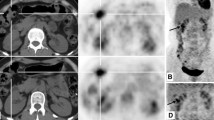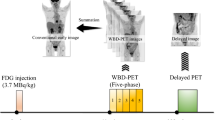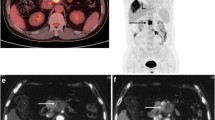Abstract
Positron emission tomography (PET)/computed tomography with 18F-fluorodeoxyglucose (FDG) is widely used for the diagnosis of malignant tumors. However, we occasionally encounter cases in which pathological accumulation is indistinguishable from physiological accumulation. We conducted a retrospective study of the maximum standardized uptake value (SUVmax) and the distribution pattern of FDG accumulation in 80 evaluable patients with records of accumulation in the small intestine identified from data acquired at Dokkyo Medical University PET Center from March 2005 to December 2010. Our aim was to distinguish pathological accumulation from physiological accumulation. Nineteen of the 80 patients had lesions that required some form of treatment. These lesions were categorized as pathological accumulation, while other 65 lesions in 61 patients were categorized as physiological accumulation. Cases with diffuse accumulation in the intestinal tract were assigned to Group L (linear), all others to Group F (focal), in our analysis. Lesions were focal in 22 patients and linear in 62. The pathological accumulation group had a mean SUVmax of 12.2, which was higher than that of 5.0 in the physiological accumulation group, and included more lesions that were categorized into Group F (16 of 19 lesions). The sensitivity and specificity for detecting focal accumulation regarded as being pathological accumulation were 84% and 91%, respectively, and accuracy was 89%. The sensitivity and specificity with a cut-off SUVmax of 5.87 obtained in the ROC analysis were 84% and 78%, respectively, and accuracy was 80%. Evaluation of SUVmax in the small intestine and the distribution pattern of FDG accumulation may be useful for diagnosing lesions in the small intestine.




Similar content being viewed by others
References
Jemal A, Siegel R, Ward E, et al. (2009) Cancer statistics, 2009. CA Cancer J Clin 59:225–249
Yamamoto H, Sekine Y, Sato Y, et al. (2001) Total enteroscopy with a nonsurgical steerable double-balloon method. Gastrointest Endosc 53:216–220
Mitsui K, Tanaka S, Yamamoto H, et al. (2009) Role of double-balloon endoscopy in the diagnosis of small-bowel tumors: the first Japanese multicenter study. Gastrointest Endosc 70:498–504
Yamato M, Kataoka Y, Mizuma H, et al. (2009) PET and macro- and microautoradiographic studies combined with immunohistochemistry for monitoring rat intestinal ulceration and healing processes. J Nucl Med 50:266–273
Minamimoto R, Terauchi T, Jinnouchi S, et al. (2013) Observer variation study of the assessment and diagnosis of incidental colonic FDG uptake. Ann Nucl Med 27:468–477
Abouzied M, Crawford E, Nabi H (2005) 18F-FDG imaging: pitfalls and artifacts. J Nucl Med Technol 33:145–155
Prabhakar H, Sahani D, Fischman A, et al. (2007) Bowel hot spots at PET-CT. Radiographics 27:145–159
Kubota K, Itoh M, Ozaki K, et al. (2001) Advantage of delayed whole-body FDG-PET imaging for tumour detection. Eur J Nucl Med 28:696–703
Kumar R, Loving V, Chauhan A, et al. (2005) Potential of dual-time-point imaging to improve breast cancer diagnosis with (18)F-FDG PET. J Nucl Med 46:1819–1824
Lodge M, Lucas J, Marsden P, et al. (2005) A PET study of 18FDG uptake in soft tissue masses. Eur J Nucl Med 26:22–30
Toriihara A, Yoshida K, Umehara I, et al. (2011) Normal variants of bowel FDG uptake in dual-time-point PET/CT imaging. Ann Nucl Med 25:173–178
Lindholm P, Minn H, Leskinen-Kallio S, et al. (1993) Influence of the blood glucose concentration on FDG uptake in cancer—a PET study. Nucl Med 34:1–6
Diederichs C, Staib L, Glatting G, et al. (1998) FDG PET: elevated plasma glucose reduces both uptake and detection rate of pancreatic malignancies. J Nucl Med 39:1030–1033
Hara T, Higashi T, Nakamoto Y, et al. (2009) Significance of chronic marked hyperglycemia on FDG-PET: is it really problematic for clinical oncologic imaging? Ann Nucl Med 23:657–669
Tatlidil R, Jadvar H, Bading J, et al. (2002) Incidental colonic fluorodeoxyglucose uptake: correlation with colonoscopic and histopathologic findings. Radiology 224:783–787
Gutman F, Alberini J, Wartski M, et al. (2005) Incidental colonic focal lesions detected by FDG PET/CT. Am J Roentgenol 185:495–500
Compliance with Ethical Standards
Conflict of interest
The authors declare that they have no conflict of interest.
Informed consent
Informed consent was obtained from all individual participants included in the study.
Research involving human participants and/or animals
All procedures performed in studies involving human participants were in accordance with the ethical standards of the institutional and/or national research committee and with the 1964 Helsinki declaration and its later amendments or comparable ethical standards. For this type of study formal consent is not required.
Author information
Authors and Affiliations
Corresponding author
Rights and permissions
About this article
Cite this article
Sugaya, T., Sakamoto, S., Tominaga, K. et al. Feasibility of detecting small intestinal disease by FDG-PET/CT. Abdom Imaging 40, 2193–2199 (2015). https://doi.org/10.1007/s00261-015-0457-1
Published:
Issue Date:
DOI: https://doi.org/10.1007/s00261-015-0457-1




